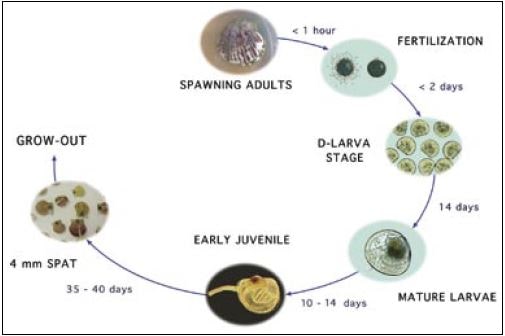2.2.2 Embryonic and larval development
These topics are covered more fully in later sections, but a brief description is given here for continuity. Larval development is similar whether initial development occurs in the mantle chamber of the female or completely in the open environment.
Eggs undergo meiotic division at fertilization to reduce the number of chromosomes to a haploid number before the male and female pronuclei can fuse to form the zygote. Two polar bodies are released during meiotic division and when apparent, indicate successful ferilization. Cell division begins and within thirty minutes after fertilization the egg divides into the two-celled stage. The eggs are heavier than water and sink to the bottom of the tank where cell division continues.
The time taken for embryonic and larval development is species specific and temperature dependent (Figure 11). Within 24 hours the fertilized egg has passed through the multi celled blastula and gastrula stages and in 24 to 36 hours has developed into a motile trochophore. Trochophores are somewhat oval in shape, about 60-80 ?m in size and have a row of cilia around the middle with a long apical flagellum and these permit them to swim.
The early larval stage is referred to as the straight-hinge, “D” or Prodissoconch I stage. Shell length of the initial straight-hinge stage varies with species but it is generally 80-100 ?m (larger in larviparous oysters). The larva has two valves, a complete digestive system and an organ called the velum that is peculiar to bivalve larvae. The velum is circular in shape and can be protruded from between the valves. It is ciliated along its outer margin and this organ enables the larva to swim but only well enough to maintain itself in the water column. When the larva swims through the water column the velum collects phytoplankton upon which the larva feeds.
Larvae continue to swim, feed and grow and within a week the umbones, which are protuberances of the shell near the hinge, develop. As larvae continue to grow, the umbones become more prominent and the larvae are now in the umbone or Prodissoconch II stage. Prodissoconch II stage larvae have distinct shapes and with practice it is possible identify larvae of different bivalve species in the plankton. This has been used by biologists to forecast oyster sets in the natural environment for the industry. Duration of the larval stage varies with species and environmental factors such as temperature but it can be 18-30 days. Size at larval maturity also varies with species and can be 200-330 ?m.

Figure 11: Representation of the developmental stages of the calico scallop, Argopecten gibbus, which take place within a hatchery. The duration of the period between the various stages is given in hours or days for this particular species and may differ for other species of bivalves.
When larvae approach maturity, a foot develops and gill rudiments become evident. Small dark circular dots, the eye-spots, develop near the centre of each valve of some species. Between periods of swimming activity, larvae settle and use the foot to crawl on a substrate. When a suitable substrate is found the larva is ready to metamorphose and begin its benthic existence. Mature oyster larvae secrete a small drop of cement from a gland in the foot, roll over and place the left valve in it. They remain attached in that location for the rest of their lives. In other species, the larva secretes byssus from the byssal gland in the foot and this serves as a temporary holdfast to attach to a substrate. The larva is now ready to metamorphose.